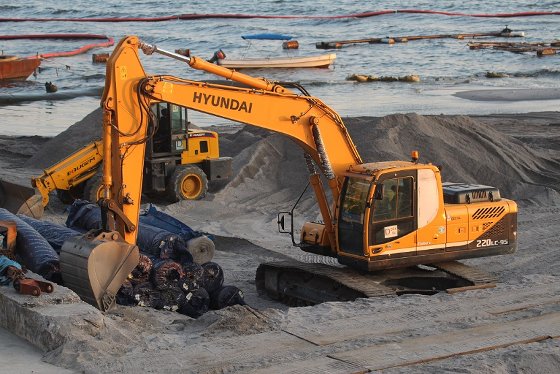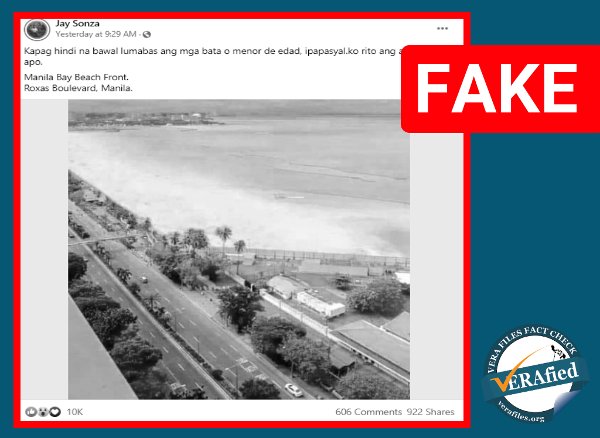By NORMAN SISON
Photo and video by LUIS LIWANAG
WITH the waters of Manila Bay murky with pollution and littered with flotsam, it seemed unlikely that anything could survive in there. But there they were, by the waterfront near the headquarters of the Philippine Navy, about a dozen locals with fishing poles last Tuesday.
“What’s in there,” asked an astonished local tourist, who was milling about and had apparently thought that the bay was dead because of the pollution. “Tilapia (St. Peter’s fish),” one fisherman answered. “The fish just won’t run out.”
Once in a while, the fishermen would reel in a good-size catch. One already had a bag full of fish, about two kilos of it.
That’s a good sign for a group of concerned citizens fighting to preserve the beauty of Manila Bay. If there is life in the waters, there is hope for saving the bay from the kind of destruction wrought by economic development done in the name of progress.
A kilometer away, hundreds of protesters began to assemble at a plaza honoring Rajah Sulayman, the last Muslim ruler of Manila. In 1570, two Spanish frigates entered Manila Bay, wrested Manila from Sulayman, and made it the seat of Spanish colonial rule in the Philippines.
Most of the protesters were students from schools around the area. Also among the throng were artists, photographers, fisherfolk, environmentalists, Catholic parishioners, leftist activists, civic-minded citizens, and a sprinkling of foreigners.
They were of disparate leanings but they had one common cause: to stop a real estate company, Manila Goldcoast Development Corporation, from building a business center on Manila’s last remaining two-kilometer stretch of boulevard by the bay.
If that stretch goes, they argued, gone will be the view of the sunset that has made Manila Bay famous — for the common people, at least.
They eyed with suspicion a yellow banner strung at the plaza supposedly by city hall for their benefit. “No reclamation between Manila Yacht Club and US Embassy,” the message read from Manila Mayor Alfredo Lim.
But no one is taking it hook, line and sinker. After all, Lim did sign a 2012 Manila city council resolution opening Manila Bay to reclamation. Many of the protesters asked: does that mean the reclamation will be done somewhere else?
As the sun began its descent over the horizon, the protesters crossed over to the bayside, briefly disrupting traffic along Roxas Boulevard. They stood on the seawall and formed a human chain that reached all the way to the US embassy a kilometer away.
While they watched the sky turn into a blaze of colors, they paid no attention to a line of 30-something rallyists behind them, who said nothing and let their placards do the talking — which repeated the same message from Mayor Lim.
Many protesters couldn’t help noticing that the rallyists clearly came from the poor section of society but could still afford to have placards made professionally for the occasion.
One remarked quietly: “The lettering is quite neat, almost stenciled.” Another protester, taking note of the election season, was more direct: “Bawal ang epal dito. (Politicians ingratiating themselves are banned here.)”
Clouds obscured the sun but the sky turned into dazzling hues of orange and red. Briefly, the orange ball of the sun peeked, and everyone on the seawall fired away with cell phone cameras. Of course, they took photos of themselves as well with the sunset providing the background.
That is the point the organizers of the rally, the SOS Manila Bay Coalition, wants to make. The bay belongs to the people.
“There is already a dearth of communal spaces in the metro as more and more development projects privatize lands and encroach on public territory,” said Dr. Jojo Carabeo, of the People’s Network for the Integrity of Coastal Habitats and Ecosystems.
“Where else can the people go to relax and watch the beautiful sunset? Reclaiming Manila Bay will deprive many of the right to appreciate nature, and will have a long-term impact on the environment and livelihood of fisherfolk. Manila Bay must be saved from this fate,” he said.
Comedienne Mae Paner was all smiles at the rally turnout, giving her hope that they could turn back the reclamation.
“Just a few days ago, we didn’t think that this many people would come. But, look, when you call on people power for a good cause, they are here,” said Paner, better known as the Internet activist Juana Change.
As the sun touched the horizon to make its final exit, the protesters raised their hands as photographers and photojournalists covering the event behind them snapped silhouettes of people against a background of fiery orange.
“The waterfront of the city is like the soul of the city,” said Fr. John Leydon, parish priest of Malate Catholic Church, built by the Spaniards in the 16th century. It stands just across the street from Rajah Sulayman Plaza.
“You don’t sell your soul. And if you do, shame on you,” said Leydon, an Irish priest who has been living in the Philippines for 40 years, and one of the protest organizers. “But souls have been sold before for 30 pieces of silver — and there’s probably inflation on that now.”




